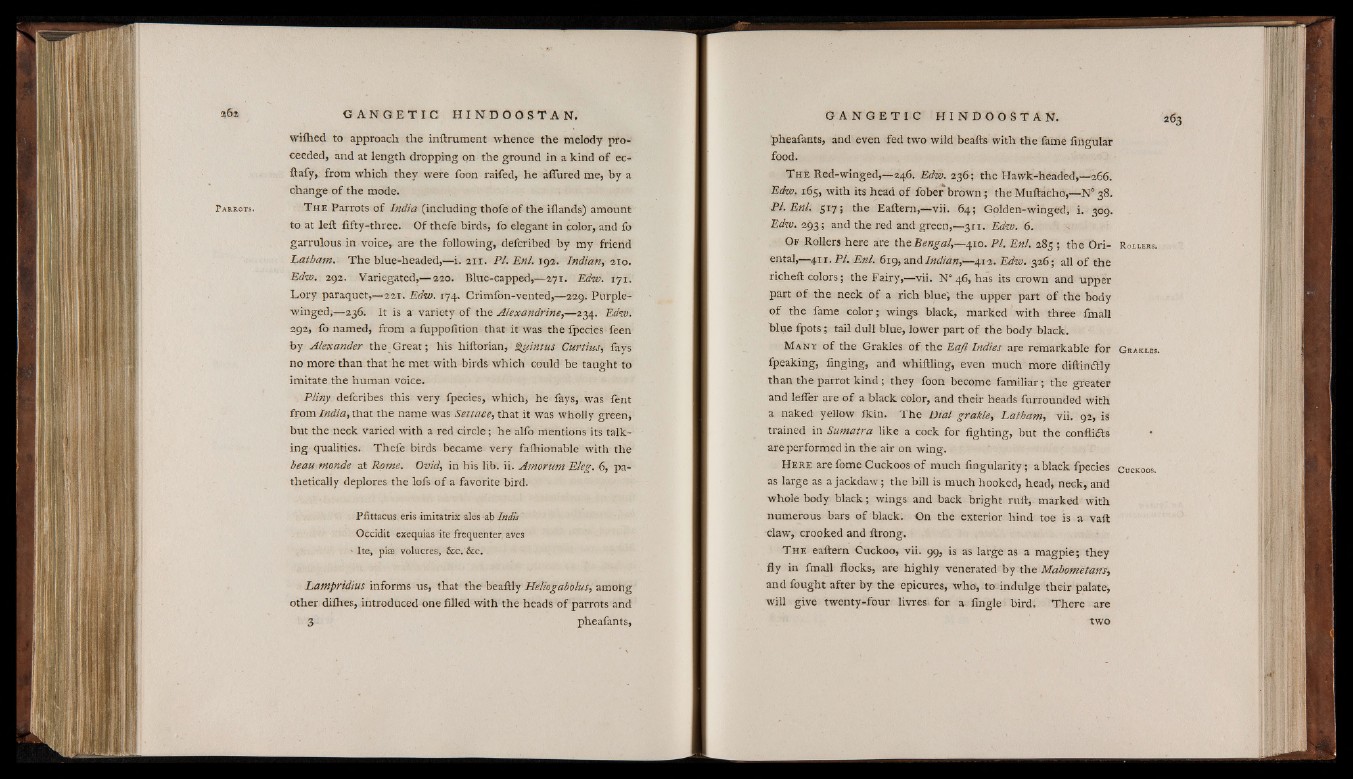
wiihed to approach the inftrument whence the melody proceeded,
and at length dropping on the ground in a kind of ec-
ftafy, from which they were foon raifed, he allured me, by a
change of the mode.
T h e Parrots o f India (including thofe of the illands) amount
to at left fifty-three. Of thefe birds, fo elegant in color, and fo
garrulous in voice, are the following, defcribed by my friend
Latham. The blue-headed,— i. 2x1. PI. Enl. 192. Indian, 210.
Edw. 292. Variegated,— 220. Blue-capped,— 271. Edit). 171.
Lory paraquet,— 221. Edw. 174. Crimfon-vented,— 229. Purplewinged,—
236. It is a variety of the Alexandrine,— 234. Edw.
292, lb named, from a iuppolition that it was the fpecies feen
by Alexander the Great; his hiftorian, ftyintus Curtius, fays
no more than that he met with birds which could be taught to
imitate the human voice.
Pliny defcribes this very fpecies, which, he fays, was fent
from India, that the name was Sett ace, that it was wholly green,
but the neck varied with a red circle; he alfo mentions its talking
qualities. Thefe birds became very faihionable with the
beau monde at Rome. Ovid, in his lib. ii. Amorum Eleg. 6, pathetically
deplores the lofs o f a favorite bird.
Pfittacus eris imitatrix ales -ab In d is
Occidit exequias ite frequenter aves
• Ite, pias volucres, &c. &c.
Lampridius informs us, that the beaftly Heliogabolus, among
other dilhes, introduced one filled with the heads of parrots and
3 pheafants,
pheafants, and even fed two wild beafts with the fame lingular
food.
T h e Red-winged,— 246. Edw. 236; the Hawk-headed,—266.
Edw. 165, with its head o f fober brown; the Muftaeho,— N° 38.
PI. Enl. 317; the Eaftern,— vii. 64; Golden-winged, i. 309.
Edw. 293; and the red and green,—311. Edw. 6.
Of Rollers here are the Bengal,—410. PI. Enl. 285 ; the Oriental,—
411. PI. Enl. 619, and Indian,—412. Edw. 326; all o f the
richeft colors; the Fairy,—vii. N" 46, has its crown and upper
part o f the neck of a rich blue) the upper part o f the body
o f the fame color; wings black, marked with three fmall
blue fpots; tail dull blue, lower part o f the body black.
M a n y of the Grakles o f the Eaft Indies are remarkable for
fpeaking, finging, and whiffling, even much more diftinaiy
than the parrot kind ; they foon become familiar; the greater
and lefler are of a black color, and their heads furrounded with
a naked yellow ikin. The Dial grakle, Latham, vii. 92, is
trained in Sumatra like a cock for fighting, but the conflias
are performed in the air on wing.
H e r e are fome Cuckoos o f much Angularity; a black fpecies
as large as a jackdaw; the bill is much hooked, head, neck, and
whole body black; wings and back bright ruft, marked with
numerous bars o f black. On the exterior hind toe is a vaft
claw, crooked and ftrong.
T h e eaftern Cuckoo, vii. 99, is as large as a magpie; they
fly in fmall flocks, are highly venerated by the Mahometans,
and fought after by the epicures, who, to indulge their palate,
will give twenty-four livres for a fingle bird. There are
two
R ollers.
G rak le s .
C uckoos.